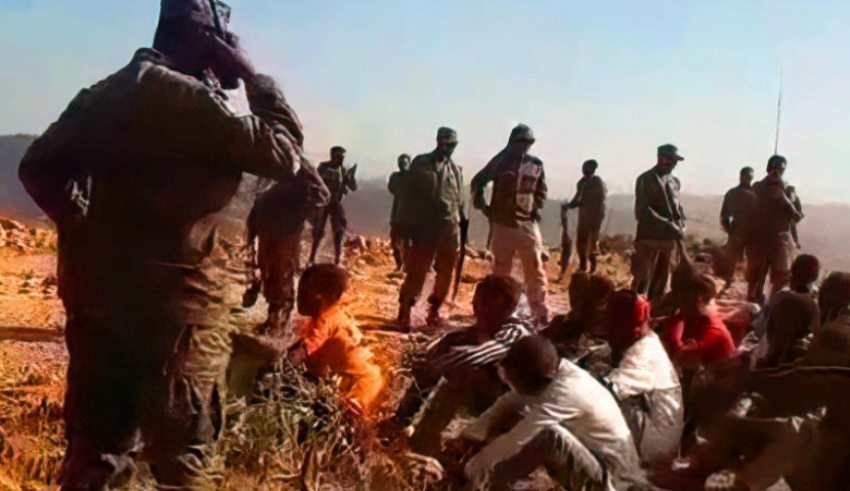
Dawit was watching television at a relative’s one-room apartment in Axum, a historic city in Ethiopia’s war-torn, northern Tigray region, in early March when a news bulletin flashed up on the screen.
Graphic, unverified footage had surfaced of a mass killing near Dawit’s hometown of Mahibere Dego, in a mountainous area of central Tigray. In the shaky video Ethiopian soldiers appeared to round up a group of young, unarmed men on a wind-swept, dusty ledge before shooting them at point-blank range — picking them up by an arm or a leg and flinging or kicking their bodies off a rocky hillside like ragdolls.
The soldiers can be heard in the footage urging one another not to waste bullets, to use the minimum amount needed to kill and to make sure none of the group were left alive. They also appear to cheer each other on, praising the killings as heroic and hurling insults at the men in their captivity.
Dawit said he believes one of the men in the video, broadcast on a diaspora television station Tigrai Media House (TMH), was his younger brother, Alula. CNN has changed the names of both brothers for Dawit’s safety.
The mass killing near Mahibere Dego is one of several to have been reported over the course of Ethiopia’s five-month-old conflict during which thousands of civilians are believed to have been killed, raped and abused. But with independent access to journalists severely restricted until recently and telephone and internet services often blocked, it has been challenging to verify accounts of atrocities in Tigray. Amid the effective communications blackout, few videos have emerged from the fighting and those that have are difficult to authenticate.
Through a forensic frame-by-frame investigation of the video footage — corroborated by analysis from Amnesty International’s digital verification and modeling experts — as well as interviews with 10 family members and local residents, CNN has established that men wearing Ethiopian army uniforms executed a group of at least 11 unarmed men before disposing of their bodies near Mahibere Dego.
Dawit said he last saw his 23-year-old brother — in the same clothes he is seen wearing in the video — at their mother’s house in Mahibere Dego on January 15. The video is not timestamped and CNN does not have the original, raw footage to examine the file’s metadata but it is likely the video was filmed that same day.
Dawit was out in the fields looking after his cattle when he said Ethiopian soldiers arrived in the town and went door-to-door dragging young men, including his brother, from their homes.
The troops shot at him, Dawit said, and he ran into the bush to escape, breaking his leg as he scrambled down a rocky path. Later, he said he could hear gunfire in the distance, and then silence.
Until he watched the video, he said he had no idea what had happened to his brother. But even after watching the footage countless times, Dawit said he is still holding out hope Alula is alive.
CNN is not able to independently verify that Alula is pictured in the footage, and the man that Dawit identifies as his brother is not identifiable among the dead.
“Since we didn’t see his body with our own eyes and bury our brother ourselves, it’s hard for us to believe he’s dead. It feels like he’s still alive, we can’t accept his death,” Dawit said.
After the attack, Dawit fled Mahibere Dego with two of his teenage siblings, limping 12 miles to their eldest brother’s home in Axum; hundreds of other residents displaced from the town and surrounding area are now sleeping rough in the city’s streets.
Dawit said the only people left in the town are those too elderly to make the trek — including his own mother. She doesn’t have internet access or satellite TV, so she hasn’t seen the gruesome video. Dawit has spoken to her over the phone — telephone networks in Mahibere Dego have been intermittent — but he hasn’t mentioned the footage. For now, he said, it is easier that way.
Ethiopia is facing a raft of intense scrutiny over human rights violations that may amount to war crimes in its Tigray region. Thousands of civilians are believed to have been killed since November, when Ethiopian Prime Minister Abiy Ahmed launched a major military operation against Tigray’s ruling party, the Tigray People’s Liberation Front (TPLF), sending in national troops and militia fighters from Ethiopia’s Amhara region.
CNN has previously compiled extensive eyewitness testimony that soldiers from neighboring Eritrea had crossed into Tigray and were perpetrating massacres, extrajudicial killings, sexual violence and other abuses.
The state-appointed Ethiopian Human Rights Commission last week said its investigations found preliminary evidence that more than 100 people in Axum were killed by Eritrean soldiers in November, confirming earlier reports by Amnesty International and Human Rights Watch.
In late March, Medecins Sans Frontieres said its staffers had witnessed Ethiopian soldiers drag several men off public buses and execute them near the Tigray capital, Mekelle.
Abiy said last week his government would hold accountable any soldier found responsible for committing atrocities in Tigray — acknowledging for the first time that Eritrean troops were fighting alongside Ethiopian forces and that they would withdraw from border areas. It is not clear whether Eritrean forces have pulled out of Tigray.
The Eritrean embassy of the UK and Ireland responded to CNN’s repeated requests for comment on March 22, denying allegations of wrongdoing by Eritrean soldiers and denying that Eritrean troops were in Ethiopia.
For months, both countries denied that Eritrean troops were in the war-torn region, and insisted no civilians have been killed in the conflict, contradicting accounts from residents, refugees, aid agencies, diplomats and Ethiopian civilian officials.
If the soldiers in the Mahibere Dego video are indeed Ethiopian National Defense Forces then it may be the first visual evidence of Ethiopia’s involvement in war crimes.
The Ethiopian government and its interim administration in Tigray did not immediately respond to CNN’s request for comment on the video and accusations that its forces abducted scores of men from the Mahibere Dego area.
On Friday, after CNN’s investigation published, Abiy’s office said in a statement that “social media posts and claims cannot be taken as evidence, regardless of whether Western media report it or not.” The statement added that the government “has indicated its open will for independent investigations to be undertaken in the Tigray region.”
The footage was initially broadcast in early March by Tigrai Media House (TMH), a pro-Tigray subscription satellite TV and YouTube channel based in the United States, and has widely circulated on social media in the weeks since.
Stalin Gebreselassie, a TMH journalist and presenter based in Washington, DC, told CNN he was sent the gruesome footage via a source in Tigray. The source told him that the video was filmed on a mobile phone by an Ethiopian army soldier turned whistleblower involved in the mass killing.
TMH paid the whistleblower directly for the footage, Gebreselassie said, so that he could leave Ethiopia and go into hiding. As part of the agreement, TMH waited until they had received word that he was safely outside the country before broadcasting the video.
“I managed to talk to him only for three minutes. The words he uttered to me were: ‘I’m so sorry brother … I am really sorry for what I did in Tigray, the Tigrayan people don’t deserve this,'” Gebreselassie said, describing his call with the whistleblower. Gebreselassie said that the whistleblower appeared to regret his involvement in the killing, and told him that he was sharing the video with TMH “to heal” and “expose what the Ethiopian government was doing to its own people.”
CNN was unsuccessful in its attempts to reach the soldier directly, and does not know the extent of the soldier’s involvement in the atrocities.
Gebreselassie said the footage was sent to him on WhatsApp in five compressed video clips, due to persistent internet bandwidth issues in Tigray, but maintains it was all filmed by the soldier on one device.
Without the raw footage and associated metadata, CNN cannot confirm the original device the five videos were filmed on, who filmed them, the date they were filmed or whether they were selectively edited.
Still, CNN was able to geolocate the video to a rugged clifftop three miles south of Mahibere Dego, identifying the terrain, tree line, vegetation and shape of the mountains on Google Earth.
Separately, Amnesty International said it confirmed the location in all five video clips using 3D modeling software that overlaid the footage on top of satellite imagery of the location.
“A preliminary geolocation for the site required additional spatial verification. The link between the collected footage and the location was then verified through spatial analysis and reconstruction,” Martyna Marciniak, a visual investigator who built the 3D model for Amnesty International, said.
To corroborate the specific time of day the video was filmed, CNN conducted shadow analysis using a tool called SunCalc. Based on the long shadows, it suggests the massacre was carried out in the late afternoon.
In freeze-frames of the footage, soldiers can be seen wearing uniforms with embroidered Ethiopian national flag patches on the shoulder and black “Ethiopian Army” stitching on the lapel. The uniforms appear to match those worn by the Ethiopian National Defense Force (ENDF), as seen in photos and footage taken by news agency Agence France-Presse in Tigray.
The soldiers can also be heard speaking Amharic — the dominant official language of the Ethiopian federal army — as they summon the young men to come forward and check if they’re armed.
“This crime is so egregious that it really merited properly interrogating the content to make sure we can 100% put a stamp on it to say, we know where this happened and we know that this happened. And we went to great lengths to do that,” Sam Dubberley, the acting head of Amnesty International’s Crisis Evidence Lab, said.
“The fact that it is a perpetrator that’s done this [filmed the video] shows a feeling of impunity, that they can get away with it. And I think it’s really important that the perpetrators of these crimes are held to account by the Ethiopian government … for what appear to be extrajudicial killings.”
By Bethlehem Feleke, Eliza Mackintosh, Gianluca Mezzofiore, Katie Polglase and Nima Elbagir
source: cnn.com














